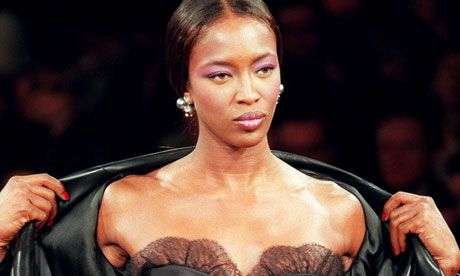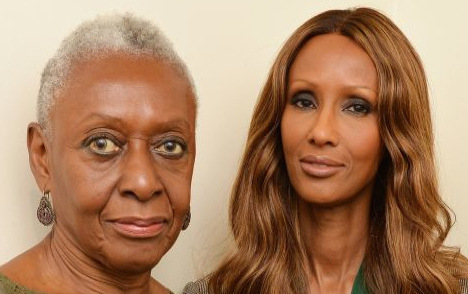17 September 1990: Is demand for Naomi Campbell and other black models evidence of greater diversity in the fashion world or just a fad?
Naomi Campbell modeling at the Yves Saint Laurent 1999 spring/summer show in Paris. Photograph: Michel Euler/AP
Open the pages of Italian Vogue, American Harpers, British Elle in fact any fashion magazine you care to mention and you will see them. Leaping across sunburned Arizona desert roads, stretching impossibly long limbs, gazing off into the near distance with pensive, unattainable stares, black models are suddenly everywhere.
These aren't the pale, European-featured black models of five or so years ago. These are real black girls.
A handful have even made the leap to supermodel status where you become a face and a name. There's the American Karen Alexander, who Vogue described as 'a fragile long-necked beauty'. There's the 6ft 2in Sebastian who Harpers & Queen recently referred to as 'looking more like a champion hurdler than a clothes horse'. And then there's Naomi Campbell.
Twenty-year-old Campbell, discovered while she was a teenager from Streatham attending the Italia Conti stage school, is now the international fashion world's personification of black beauty. Flick through your average international fashion glossy and what do you see? Photo of Naomi, advert, another photo of Naomi, advert, advert featuring Naomi, advert, article on short hairstyles featuring, yes, Naomi. Fashion designer Azzedine Alaia describes her as 'a tiny, divinely muscular boxer' though it is hard to imagine anyone who looks less like Barry McGuigan.
So beautiful is Naomi that she recently appeared on prime-time American TV in The Cosby Show, playing simply every man's idea of an impossibly beautiful college girl, yet this still doesn't explain why she occupies more pages in Italian Vogue than Gazza does in The Sun. Have fashion editors been belatedly taking a crash course in positive discrimination? Is it an extreme form of liberal white guilt? Never. Fashion editors are favoring black models because it's, well, fashionable.
According to Debbi Mason, former fashion director of Elle and now a top freelance stylist, 'The important thing to remember about the new popularity of black models is that it's a fashion in looks rather than a change in attitudes. It's linked with the idea of global fashion. At the moment, there's very much a fashion for mixed culture and putting eclectic things together, and I think black models emphasis that. It's just a fashion. It could have been big noses or long hair. It's like everyone going out and cutting their hair short.'
In fact black models have become so fashionable in the ad world that advertising people have taken to calling them GBCs - Groovy Black Chicks. Creative directors get them dancing away like something out of a Soul II Soul video in adverts for cashline cards or fashionable dance music album compilations.
Mason was at Elle in the mid-eighties when the magazine first booked Naomi Campbell. 'We had a lot of encouraging letters from black readers saying it was good, at last, to see black models used in the magazine,' she says. Today dark-skinned models with features so non-Caucasian that The Cosby Show would probably reject them are finding themselves welcomed with open arms in the fashion world.
 Former models Bethann Hardison and Iman, 2013. Photograph: Mike Coppola/Getty Images
Former models Bethann Hardison and Iman, 2013. Photograph: Mike Coppola/Getty Images
Lorraine Pascale, an 18-year-old recently signed to Models One in London, says, 'The situation is better than it has ever been. It's certainly a lot easier for black models working today. For some reason I get a lot of work in Australia at the moment I don't think that's because I'm black, but because there aren't very many models working down there.'
Adored though they might be by the fashion cognoscenti, however, black girls still don't get their fair share of magazine covers. Naomi Campbell has made it to the cover of British Vogue twice but, significantly, the first time was in long-shot rather than close-up and the second was a group portrait of four models. As Debbi Mason says, 'According to market research, black girls on covers don't sell and this is something I feel very sad about.'
At Cosmopolitan, editor Marcelle D'Argy Smith feels that this kind of conventional wisdom is 'very old thinking and out of date, like people going on about the suicide rate in Sweden.' Cosmo put its first black girl on the cover in 1973 and its latest one on the August issue. It has to be said, though, that black girls on the cover of Cosmo generally have their skin bleached out to a peanut butter colour, so they look not so much like black girls or even white girls, but simply Cosmo girls. And D'Argy Smith, while quick to point out that Cosmopolitan uses 'a disproportionate amount of black girls ', is equally quick to note that Britain as a whole is still 'bloody racist, a very racist society', compared with America where black models are far more numerous.
Irene Shelley, editor of the British black fashion magazine Black Beauty & Hair, tends to agree. 'We've seen changes in the way women's magazines use black models. Now they're used more just as other models would be used, instead of being plonked in there if you had a carnival fashion shoot. But we're still stuck with a lot of pictures of the stereotyped fashion magazine black girl you know, pale skin and long, flowing, corkscrew hair.'
THE FACT that Naomi Campbell is so visible, Shelley adds, doesn't mean there's necessarily been an explosion in the actual numbers of black models working. 'Most agencies can take only one or two on their books at a time, so the majority of black models end up working part-time at other jobs.'
Her opinions are borne out by fact. Of the 75 models on the books at the London office of Models One, an established model agency in the business for 25 years, only six are black. Five years ago that number was a grand total of one. And though girls are allowed to look black now, their hair, by and large, is still not. Black hair tends to be cropped very short, straightened or stuffed under straight, often blonde, wigs, to capitalize on the new sixties-inspired fashion. Even pop stars Janet Jackson and Jody Watley have stolen the look and appeared in American glossies sporting blonde Barbie-doll wigs, looking like modern-day Motown starlets.
Debbi Mason cautions that the sudden increase in the number of black models is no cause for the fashion world to congratulate itself. She predicts that numbers will decline when black models go out of fashion. 'It's quite interesting that at the moment you never see oriental girls in magazines. It's just not fashionable right now. But I'm sure there will be a time when it will be and suddenly we'll start seeing a lot of oriental faces.'
She feels, however, that the current fashion for using black models may go a small way towards changing the future long-term perceptions of beauty. 'In a way its like the hype surrounding New Age,' she says. 'You feel that something has to come out of it. Even if the motivation to begin with isn't right, it has to have a good effect.'
In September 2013, former models Bethann Hardison and Iman joined forces with Naomi Campbell to launch Balance Diversity, a campaign to promote the visibility of black models.
No comments:
Post a Comment